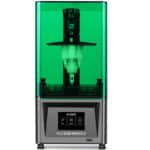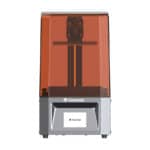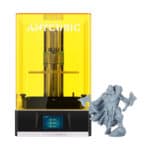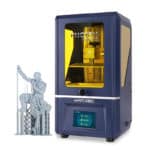Best Resin 3D Printer in 2022
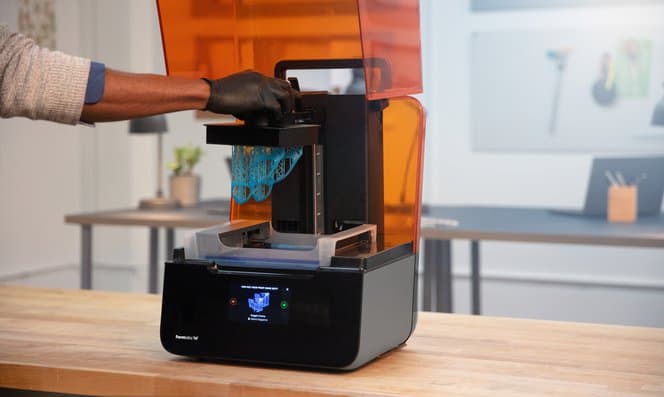
What is 3D printing?
Right, so you are here which I’m taking as you having an interest in 3D printing already. I’m also assuming (hopefully correctly) that you are no expert and either want to find out more or expand your existing knowledge.
3D printing is the process of making an object out of material. Just like “normal” printing takes a blank sheet of paper and turns it into a sheet of words, or a photograph or whatever, a 3D printer takes, well thin air, and eventually chucks out a 3D item – be it a model or whatever that you sent to it.
3D printing is the process of additive manufacturing which is a fancy way of adding something to something to eventually make something else. Don’t be afraid of the term, children use additive manufacturing when they are building something out of lego. We don’t need a degree here.
Instead of Lego, a 3D printer takes information sent in the form of a 3D object, sliced into tiny layers, and then goes about building the layers on top of each other until you get the end result. Lego again. If you want to mess with the space/time continuum you could even use one to make your own Lego. That’s extreme additive manufacturing!
To do this we need to use a program called a Slicer. Just like we use a word processor for sending text to an Inkjet printer we use a slicer to send information about our object to the 3D printer and just like a word processor performing this task, much of the hard work is done for us.
Of course, we still have to do some of the initial hard labor ourselves but if you are just looking to get something printed out you can just download a model from the internet, automatically slice it and send if to the printer and end up with spectacular results (alongside the occasional gooey disaster!)
Products at a Glance
Best Resin 3D Printer in 2022
- Perfect build size for models
- Market leader in budget 3D resin printing
- Large online support community
- 2K mono screen will last a long time
- Not the cheapest so position may come under threat soon
- Decent build size
- Fantastic price
- Simple to level build plate
- Perfect for intro to resin printing
- 2K mono screen will last a long time
- No network connection. USB only
- A little noisy when lifting print layers
- Build size is great for models
- Large user base so easy community trouble-shooting
- 2K mono screen will last a long time
- More expensive than the Proxima
- Large build volume
- 4k Screen
- faster exposure time, so quicker prints
- Costly
- Sturdy
- Wi-Fi connection
- A step up from budget standard
- Very fast layer curing
- Expensive for hobbyist use
What is 3D Printing with Resin?
Today we are going to be dealing specifically with 3D printing with resin – or SLA printing as it is known in the trade. There are two main kinds of 3D printing – FDM – which you may have seen and involves a spool of spaghetti-sized plastic which then passes through a “hot end” which melts the living daylights out of it to a near liquid form which is then “drawn” onto a build plate and rapidly cools down. Then the process repeats many thousands of times over with a new layer of melted plastic being deposited on top of the last one, gradually forming your desired shape.
These shapes can be things such as models, toys, even spare parts. You can even build parts to enhance your 3D printer. It’s all very cool.
Resin, or SLA, 3D printing differs in that instead of taking a solid plastic, melting it into a form, and letting it harden again, it takes a liquid resin held in a small VAT and cures the desired shape with a flash of UV light (which hardens the resin – science stuff, we’ll deal with that later.
Then the resin printer’s build plate moves up and the process is repeated, again, gradually building up your item.
If this all sounds like witchcraft that’s what it felt like to me at first. I have had an FDM printer for a couple of years but only recently made the leap to resin as the price of the machines has tumbled of late.
What can you make with a 3D printer?
The world is your oyster – to a point. You can only print out things as large as your printer’s Build Bed will allow, and in the realm of consumer home-use 3D printers that we are dealing with here, that means objects that are pretty small in reality.
You would struggle for example to build out a stand for your laptop as it simply wouldn’t fit on the build plate of a cheap 3 D printer. There are ways around it, you can chop up the object and print it in several sections and then simply Super Glue it together when it’s done – and indeed many makers do that if they are making props or prototypes, but if you are looking to 3D print a Mandalorian helmet so you can do some crazy cosplay, just be aware you are going to have to do more work than pressing CTRL-P.
How do resin 3D printers work
Stereolithography belongs to a family of additive manufacturing technologies known as vat photopolymerization, commonly known as resin 3D printing. These machines are all built around the same principle, using a light source—a laser or projector—to cure liquid resin into hardened plastic. The main physical differentiation lies in the arrangement of the core components, such as the light source, the build platform, and the resin tank.
SLA 3D printers use light-reactive thermoset materials called “resin.” When SLA resins are exposed to certain wavelengths of light, short molecular chains join together, polymerizing monomers and oligomers into solidified rigid or flexible geometries.
Assuming that means nothing to you, in lay terms your printer will lower a build plate into a vat of uncured resin suspended over (generally speaking) an LCD screen which will display an image for a few seconds. While the image is displayed UV light is leamed through the image which cures (solidifies) a think layer of resin in the shape. This is then repeated for subsequent layers adding more and more cured resin to the shape as the build plate gradually rises upwards from the vat. It’s a very cool process.
Are resin 3D printers better?
It all comes down to what want to print. It’s perfectly reasonable, and many people do, have a resin and a filament FDM printer. Resin printers are much better if you want to print, small detailed models – maybe miniatures for printing, or other intricate parts such as jewellery. Unless you are prepared to spend big on a resin printer though you will be limited to printing much smaller items than even on the most budget filament 3D printer.
Resin is also more costly and indeed messy to print with but the results can be truly spectacular.
How much does a resin 3D printer cost?
The price of 3D resin printers continues to fall dramatically with the Proxima from Voxelab now regularly picked up for around £170/$170 which is an insane price for the quality you can get from this machine. If you are looking for a resin printer to build larger models with the cost will rise dramatically to $600+, but in truth, most people will be absolutely fine with the small form factor ones. Certainly while they are learning the ropes.
How dangerous is resin 3D printing?
Dangerous is a strong word. You are unlikely to kill yourself printing a few small toy soldiers or a model of the space shuttle but there are definite precautions you NEED to take when printing with resin. The first, and most important coming from the fact the raw material is in liquid form is you absolutely do not want to get it on your skin. Rubber gloves are a must. You also need to take precaution not to let splashes get into your eyes. It is remarkably easy to slosh and splash it around so safety glasses are definite plus. Resin is a huge skin irritant and if you get any one you you need to wash it off immediately and if you ingest it or get it in your eyes you need to seek urgent medical attention to be on the safe side.
Also be careful of secondary contact, such as drips and the like on your desk that you might not realise are there until you have put your hand in them or the cat has walked across them. Take your time, take sensible precautions and you will be just fine.
Which is better FDM or resin?
It really depends on what you want to print. Resin is better if you want to print small detail objects, FDM is better for larger more functional parts, although you can still print highly-detailed models with filament with a little practice. Note though that they are totally different techniques – you can’t print with resin on an FDM printer and vice versa.
Our Verdict
This is really tough as there is actually very little difference in the printers in the resin market at the moment. The differences in technology are minimal so it will generally come down to a couple of key factors – price and build volume – and both are directly linked to each other. The printers that fall in the sub-$300 category are pretty much identical in terms of build size and price, the exception being the new kid on the block – the Voxelab Proxima, which is actually the printer I use at home.
With that in mind, the established Mars 2 Pro from Elegoo takes the crown even though it is more expensive and not *that* different. It’s just easier to get supplies for at this moment in time. Will I come back and revisit this article in six months or so and update it if things have changed. I certainly will. I’ll also be a lot further into my relationship with my own Proxima by then.
The other factor is size. If you want or need to build bigger stuff then you are going to be looking at a machine such as the Saturn (impossible to get hold of at the moment) or the Mono X which offers that extra breathing space that really does make a difference. Unfortunately, this extra size also makes more breathing space in your bank account. If you are just getting into the hobby it’s probably more advisable to start off with one of the smaller machines to cut your teeth on before looking to upgrade when you decide it’s for you..


